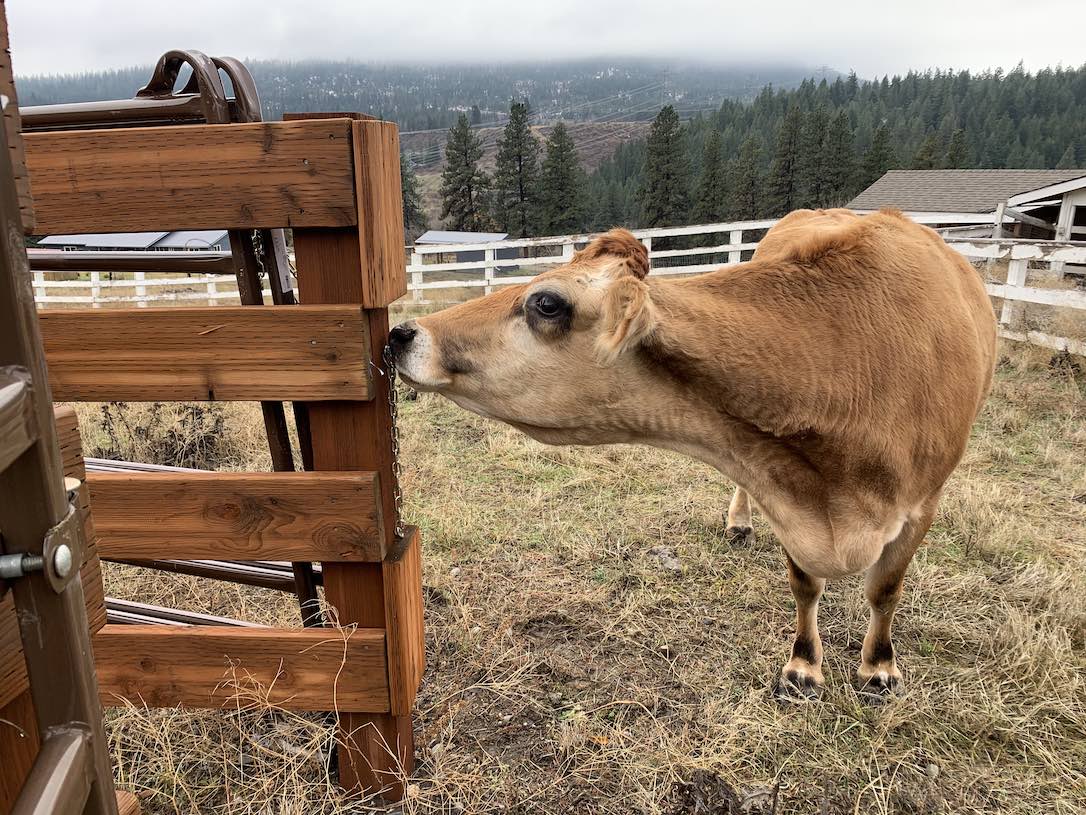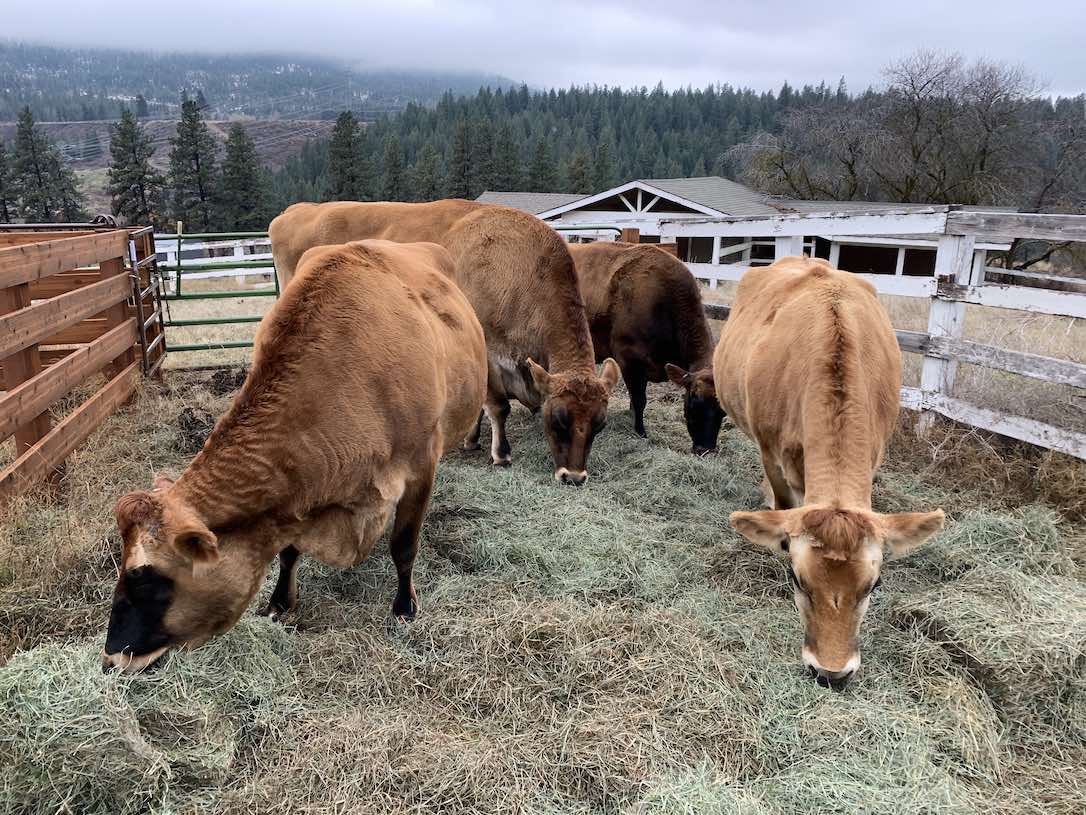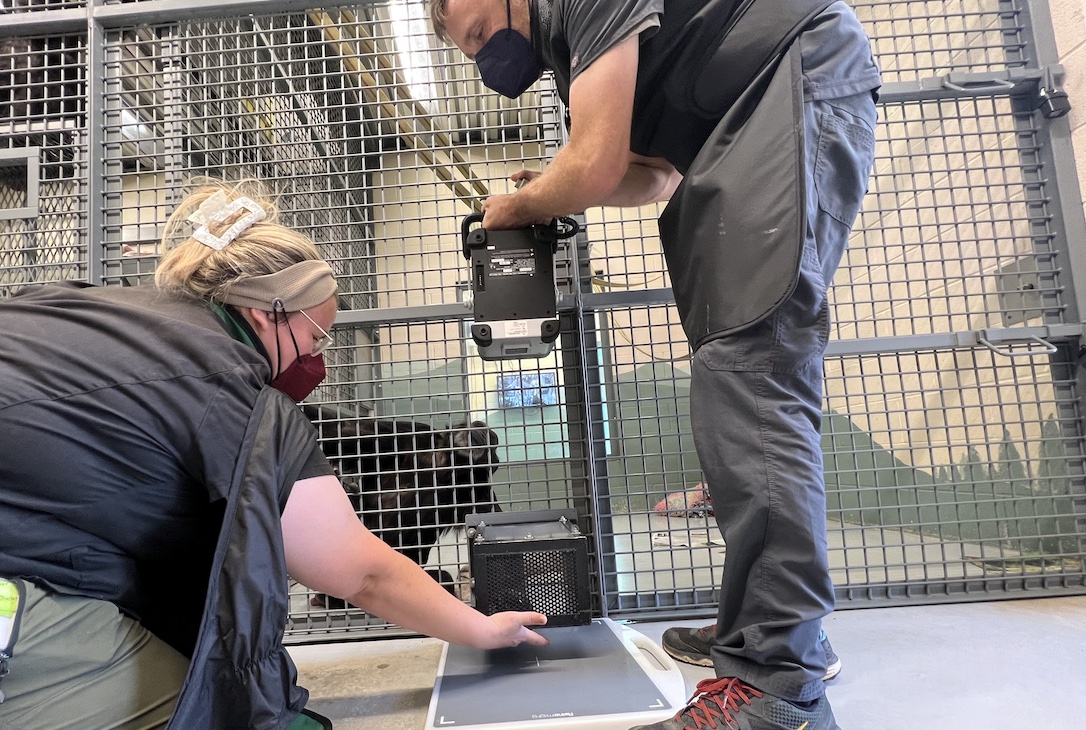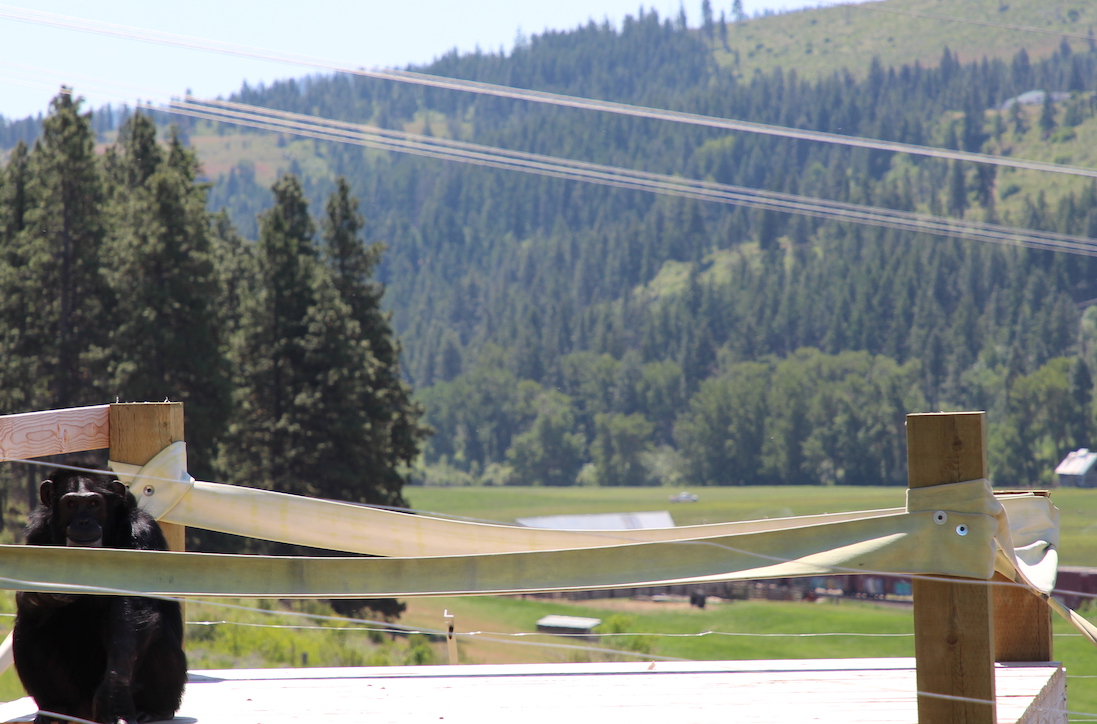As avid CSNW blog readers know well, most veterinary procedures for chimpanzees are traditionally carried out while they are under anesthesia, and we don’t like do anesthetize any more than we have to. So we, along with many of our colleagues, try to find ways for chimps to willingly cooperate in their own care. That can take the form of positive reinforcement training, the use of specialized devices for diagnostics and treatment, or, in some cases, both. Take a peek at our team snapping some x-rays of Rayne’s finger in an effort to rule out a fracture and direct the course of treatment.
positive reinforcement
Positive Reinforcement Training (PRT) with Rayne
Rayne is an absolutely beautiful chimpanzee. However, if you have not noticed before, she also has dry skin on her forehead. I believe it is just genetic, as I know entire chimpanzee families at other sanctuaries that all have the same dry forehead. While I’m not sure if her dry forehead skin bothers Rayne, she does scratch it often. My main role at the sanctuary, apart from being a chimp caregiver, is to work on Positive Reinforcement Training (PRT) with the chimps. PRT allows the chimps to participate in their own medical care, which is really amazing.
Lately, I’ve been working on PRT with Rayne, so that she would allow us to apply coconut oil/mixed with Honeysuckle lotion to her forehead. We have decided to avoid sprays because it is so close to Rayne’s eyes, so instead, I use a paintbrush to brush on the moisturizer.
As you will see in the video, I presented Rayne with the gestural and verbal cue for “head”, which she then presents her forehead by leaning forward to the caging. As soon as Rayne presented her forehead, I used my clicker to bridge the behavior, this is a way to tell Rayne she is doing everything correctly. I then presented my paintbrush to Rayne and say “touch” so she knows what I intend on doing. While Rayne is still presenting her forehead to the caging, that allows me to use the paintbrush to apply moisturizer to her forehead. I know Rayne doesn’t like for the paintbrush strokes to be too long, so as soon as I touch her forehead with one swipe, I use my clicker to let her know that reinforcement is coming, which is a blueberry. Rayne and I do this probably 15 times together until her forehead is coated. We will continue to work on her allowing me to use the paintbrush for a longer duration. However, a win is a win. We just want Rayne to be comfortable and make sure her forehead skin does not bother her.
Teamwork
Bite wounds are probably the most common injuries we see in chimps. Our treatment protocols for these wounds tend to be fairly conservative: administer analgesics for pain, clean frequently with antiseptic spray, and monitor closely. There are a few reasons for this. First, chimps have a superhuman (literally) ability to heal. Wounds that would send me racing to the ER for stitches will close up on their own in chimps with little to no treatment in a matter of days or weeks, remaining uninfected and leaving no visible trace once healed. Second, because of the frequency of wounding in captive groups, there’s always a risk of antibiotic resistance if antibiotics are over prescribed. And third, many forms of diagnostics and treatment require the chimps to be anesthetized—something we avoid whenever practical out of concern for their overall safety and well being.
Once and a while, though, there are wounds that require a bit more than the typical conservative approach—like recently, when Rayne received a bite to her third digit (middle finger) that resulted in some swelling. When the swelling persisted even as the wound appeared to heal, Dr. Erin wanted to rule out an underlying fracture. Thankfully, our Positive Reinforcement Training (PRT) team was able to train Rayne to hold her hand in the x-ray box so that we could get some images without the need for anesthesia.
Here, Jenna asks Rayne to hold her hand flat in the box so we could get the first in a series of shots.
Jenna then withdraws her hand and Rayne holds hers still (while that other hand is trying to investigate the x-ray generator!).
The good news is that Rayne did not have a fractured digit. Interestingly, you can see an old healed fracture on her 2nd digit (index finger).
Though the swelling soon began to subside, PRT also made it possible to treat Rayne’s finger with a therapeutic laser to help encourage the healing process. For this, Rayne needs only to sit at her station marker and respond to Grace’s command to present the fingers of her left hand through the mesh. It was Rayne’s choice to pull up the orange ball and sit on it.
Sabrina is then able to program the laser, at Dr. Erin’s direction, and apply it to Rayne’s finger.
The only problem? Everyone wants a turn!
Positive reinforcement training requires a lot of staff time but these little opportunities to apply all that effort can really add up in the form of improved diagnostics, more effective therapies, and fewer trips to the clinic. Even if we learn that a chimp will require a more complex exam or treatment under anesthesia, we can often go in with a head start given the information we are able to obtain.
For her part, Rayne seems pretty happy to participate.
You want me to rotate my hand 90 degrees for a lateral view?
Here, you can laser my feet, too!
Just keep that juice coming.
Bless this Mess
Knowing what you should do and doing what you should do are two very different things.
When a chimpanzees refuses to cooperate with the daily routine, you should take the opportunity to problem solve. Why do they refuse to shift? Are they anxious about being confined to certain areas with other chimps? Is there something about the space they won’t leave that is particularly appealing to them? Or are they simply looking to exert control over their environment? Then you use your hypotheses to create a plan. For example, you could desensitize them to whatever is causing their anxiety through positive reinforcement, make the other areas more appealing to them, or find other more fruitful ways for them to exercise their autonomy.
What you shouldn’t do is catch them off guard and close them out when they least expect it. But like I said, knowing and doing are two very different things! This is why I like teaching – the students never have to know that you can’t even follow your own advice.
Our latest example of what not to do involves Honey B. Honey B has decided that the Mezzanine does not need to be cleaned. We beg to differ, as do our licensing and accrediting agencies, one would assume. So each morning after breakfast, when the playrooms and greenhouses have been cleaned, we ask her to leave the Mezzanine so we can wash it down. And each morning she politely declines.

Now, one day without cleaning is not that big a deal. It’s not routine but it happens. But after two days we have a problem. And this morning, Honey B was looking to throw another wrench in the works. After several minutes of pleading with her, I gave up and accepted defeat. Honey B would get to keep her Mezzanine – and its mess – yet again.
Later in the afternoon, I walked through the greenhouse hallway and was greeted by Honey B. It occurred to me that I just walked by Mave and Willy B in the playroom. THE MEZZANINE WAS EMPTY. We didn’t have much time.
I grabbed my radio.“J.B. to Anna…No one is in the Mezzanine now if you and Kelsi want to close the door!”

Upon hearing the sound of the hydraulics, Honey B headed towards the Mezzanine but the door was already closed. Feeling guilty, we gave her and the gang some gum and jumped into cleaning like a NASCAR pit crew. Pick up! Rinse! Scrub! Rinse! Squeegee! Put out fresh blankets and enrichment!
As the locks clicked shut we did our final security checks and we were ready to let her back in. I knew that she’d be so relieved to be back in her favorite space.
I opened the door and she…just stayed in the playroom.

Well, at least we have more data for our problem-solving sessions, once we finally get around to doing the right thing. And maybe a new hypothesis: She just likes the mess?
******
If you’d like to help Honey B create more messes and help us continue to clean them up, please check out our wish list full of enrichment and supplies!
The Bud Box
Primates and Bovines
Most of our staff were, at one point or another, either primatology students at nearby Central Washington University (CWU) or interns at the university’s Chimpanzee and Human Communication Institute. People are often surprised to learn that CWU students can specialize in primate behavior at the undergraduate, graduate, or professional certificate level. It’s quite the niche.
We sometimes joke about our research-oriented backgrounds whenever we catch ourselves doing strange tasks around the Chimp House (like fishing stray troll dolls out of the septic tank filter, perusing Amazon for Jamie’s next favorite picture book, or shoveling chimp-size paths through the snow on Young’s Hill). Irony aside, the people who use their Primate Behavior degrees exclusively for studying primate behavior are the true anomalies. The skills developed while studying primatology are widely applicable to a variety of different career paths, and most of us end up doing things we never even dreamed of when we were students.
This point was reiterated when I remotely interviewed for a caregiver position at CSNW. One of the topics that came up was that of cattle care, which is quite different from the other Chimp House duties and may have turned off some candidates. When J.B. asked if I had any familiarity with bovines, I responded that “I have never cared for cattle.” The phone went awkwardly silent for a second, and I quickly realized my strange wording suggested I didn’t like cows. Of course, I actually meant that I had literally never worked with them before, and I tried my best to convey that I was in no way prejudiced against cattle. In fact, I knew little about bovine health or behavior but was super stoked to learn.
Shifting For Safety
In some respects, taking care of chimpanzees is vastly different from managing domesticated animals such as cattle. Sometimes, though, the overlap is considerable. From my perspective, one similarity shared by all species is the tendency to not go where you want them to, making their care more difficult.
We’ve recently discussed the challenges of shifting chimps around the building so that we can safely unlock areas for cleaning. In some cases, such as Willy B’s epic filibusters in the Courtyard and the chute, we can make alternate plans that align with the chimps’ preferences. However, we don’t always have that luxury. On rare occasions, we encounter situations when we need the chimpanzees to leave an area for their immediate safety. These improbable events may be related to extreme weather, enclosure maintenance, or dangerous wildlife. In these critical moments, confused chimpanzees tend to pay less attention to their caregivers and are less likely to cooperate.
One example is that of Burrito’s rattlesnake encounter in Young’s Hill back in September. On that day, the chimps voluntarily came inside, letting us administer antivenom to Burrito and remove the snake from the habitat. In the weeks after, we prioritized recall training. To execute a recall, we invite the the chimps to return to the building, letting us close the doors in exchange for high-value treats. In a couple of cases, this proactive cooperation helped us to humanely relocate non-venomous snakes that had mistakenly found their way into the chimps’ outdoor enclosure. Once the warm weather returns in the spring, we will surely resume this training.
Note: We are frequently asked whether we intervene in fights by splitting the chimpanzees up. We usually do not. Separating a frenzied group of chimps during an altercation is extremely difficult since they are so focused on each other during these moments. They almost always resolve the conflict and reconcile without our assistance.
Other institutions do similar activities for the sake of their chimpanzee residents. At the closed Wildlife Waystation (from whence came Honey B, Mave and Willy B), caregivers are currently teaching the chimps to willingly shift into transport cages in case nearby wildfires threaten the facility again. This ongoing effort recently garnered some well-deserved media attention. As the sanctuary community works to re-home the remaining chimps, it’s good to know that their immediate wellbeing is still a top priority. When those chimpanzees make their way to accredited facilities like ours, hopefully they’ll be like Honey B and bring their cooperative attitudes with them.
The Bud Box
Of course, the chimpanzees aren’t the only CSNW residents who need this kind of training. The sanctuary’s four cattle are also managed using positive reinforcement, and training them to voluntarily enter a smaller corral is one of our top priorities. Plausible scenarios in which we would need to confine the cattle would be to address individual health concerns, to make repairs to the pasture fences, or to evacuate the herd due to a nearby wildfire. We also use a similar process to isolate them for their annual hoof trims and vaccinations. In all of these cases, the first step is to get them out of the larger pasture and into a smaller corral. From there, we herd them into an even smaller pen and then into a narrow chute that allows for safe handling. Cattle are naturally skeptical of anything that seems different (and for good reason), so anything we can do to familiarize them with this process has a positive effect on their welfare.
The key to all this is the Bud Box. Although it sounds like a monthly subscription service for cannabis enthusiasts, the Bud Box is actually a type of cattle pen named after its late inventor, Bud Williams. Bud’s design was (and remains) quite simple: a rectangular enclosure that has one or more outflows located near the main entry gate. Cattle will often turn back once they encounter a dead end, at which point they easily divert into a narrow chute for veterinary care or transport. This relatively cheap design is wildly effective and popular. J.B. built our sanctuary’s Bud Box shortly after the cattle arrived, and it’s already proving to be worth all of his hard work.

As the above diagram shows, the Bud Box is designed to keep the cattle “flowing” into the chute without much human participation or promise of reward; their aversion to containment drives them through. Ideally, all the human operator has to do is close one gate and open another. Still, it can work better if the animals are familiar with the pen and relatively relaxed. Training is one way to achieve this.
Erin and I have been doing some Bud Box training recently. During these sessions, we put some of the bovines’ regular hay into the box and then briefly close them inside. Then, we open the side gate so they exit through the corresponding chute, receiving the rest of their hay as a reward. Afterwards, we leave the swing gate wide open so that they can re-enter the Bud Box for any leftovers. The following photos show a step-by-step record of the entire process (in case you want to try it with your beloved Jersey cattle at home).













Our plan is to continue this training on a weekly basis until the cattle calmly enter the Bud Box and exit via the chute with only a tiny bit of coaxing. It may seem like a lot of work now, especially for a bunch of primatology nerds like us, but this training could prove invaluable if we ever have to round up the cattle in a hurry.
In the meantime, I think we all need to appreciate how awesome Nutmeg’s hairstyle is. This anatomical feature is actually an occipital protrusion called a poll, but I think it looks more like a messy man-bun. Either way, he rocks it.
Training Fun
Getting chimpanzees to participate in their own medical care is incredibly important for their physical and psychological health. But some chimps, like Foxie, are reluctant to take part. After three decades in laboratories, who could blame her? But with patience, and lots of positive reinforcement, the chimps do learn to trust us. Sometimes, you just have to bend the rules and have a little fun.
Willy B spent some quality time in the courtyard today. I watched as he walked about eight feet across the grass to retrieve a cherry from the ground. He used a small plastic chair almost like a walker so that he had a grip on something familiar. Once he was safely back on the boardwalk, he pant-hooted and then climbed back up to the platform to relax. He even laid down in the shade out there for a while. He’s getting to the point where he only goes back inside for lunch…what a difference a month makes.
And guess who reached out to grab some cabbage from the boardwalk? This is how Willy B started – we’ll see if Mave follows the same course.
Cooperative Feeding
Willy B is a thief.
Bear in mind, it’s a very minor blemish on his otherwise flawless character. And he’s certainly not the first chimpanzee in history to steal. But it is a problem.
At each meal, Willy B takes what is his and then helps himself to everyone else’s. You can get away with that when you are 175 pounds of muscle. But Honey B and Mave need to eat, too, and none of us need all that drama. While we could isolate Willy B in a separate room during meals, that could lead to pent up frustration and it would certainly be logistically challenging at times. This is where positive reinforcement training comes in.
For many years, we’ve used positive reinforcement training to encourage the chimps to cooperate with medical procedures. Those same techniques apply to husbandry challenges as well. The other day, Anthony built a moveable “target” just for Willy B. After being trained to orient towards and touch the target, Willy B is now learning to remain wherever the target is placed, a behavior known as stationing. Stationing allows us to create some distance between the chimps while they eat. At the same time, he’ll learn that he will be amply rewarded if he remains at his station the entire time and allows the girls to receive their food. Taken together, this is known as cooperative feeding. Mr. Dominant Chimp gets the special privileges he deserves and no one goes hungry. Everyone wins.
This is something I have come to love about working with chimpanzees. You can’t force them to do much of anything, so you are required to demonstrate a little patience and humility. I often visualize it as a choice between trying in vain to dam up a stream and slowly and methodically carving out a new path for the water to flow in a more favorable direction. One day I hope to put this lesson into practice in other areas of my life but let’s not get ahead of ourselves.
On a side note, there may be a reason why Willy B was so quick to learn to station. On the other side of the Frisbee there is a pattern with a reflective surface in which he can catch glimpses of his own beautiful face.
Now we may need to train him to look away from his own reflection long enough to eat.


























